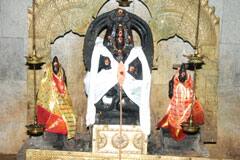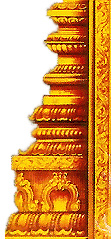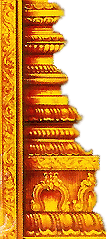|
|
Home >>
Murugan >
sri Muthukumaraswamy temple
|
| |
- Details
- Path
- Map
- Photos
- Near By Temple
| |
| Sri Muthukumaraswamy temple |
|
| |
|
![[Image1]](http://img1.dinamalar.com/Kovilimages/T_500_1143.jpg)
|
| | |
| | | |
|
|
|
Moolavar | : |
Muthukumarar |
|
|
Urchavar | : |
Muthukumarar | |
|
Amman / Thayar | : |
Valli, Deivanai | |
|
Thala Virutcham | : |
- | |
|
Theertham | : |
Swetha River, Bay of Bengal | |
|
Agamam / Pooja | : |
- | |
|
Old year | : |
1000-2000 years old | |
|
Historical Name | : |
- | |
|
City | : |
Parankippettai | |
|
District | : |
Cuddalore
| |
|
State | : |
Tamil Nadu |
| |
|
|
| |
|
|
 | Singers: |  |
| |
|
|
| |
- |
|
| |
|
|
 |
Festival: |
 |
| |
|
|
| |
Navarathiri, Kandasashti, Annabishekam, Thirukkaarthigai, Thaippoosam, Sivarathiri, Panguni Uthiram. During the Kandasashti and Thaippoosam festivals the divine weddings of Deivanai and Valli are performed respectively. On the Thaippoosam and Maasi Maham days Lord Muruga goes to Swetha River and Bay of Bengal respectively and has ‘Theerthavaari’ (Holy Bath). |
|
| |
|
|
 |
Temple's Speciality: |
 |
| |
|
|
| |
During the festival time Lord Muruga, apart from his designated carriers such as goat and peacock, comes in procession on Rishaba vaahanam and Iraavatham, the white elephant of the divine world. It is said that the Lord takes his procession on Iraavatham acknowledging the worship of Lord Indra who received benediction from this place. Itumban, who was graced by Muruga is also here as a carrier. The Lord seated on him also goes in procession. |
|
| |
|
|
 |
Opening Time: |  |
| | | | | |
The temple is open in the morning from 8.00 till noon and in the evening from 5’0 clock till 8.00 pm. |
|
| | | |
 |
Address: |  |
| | | | | |
The Administrative Officer, Arulmigu Muthukumaraswamy Tirukkoil, Parankippettai –608 507, Cuddalore District. |
|
| | | |
 |
Phone: |  |
| | | |
| |
+91 84184 11058, 98940 48206 | |
|
| | |
 |
General Information: |  |
| |
|
|
| |
Swethanathier, father of Babaji who is said to be in Himalayas, was serving as an archaka (priest) in this temple only. At a distance from here in his birth-place is the temple of Babaji. |
|
| |
|
|
 |
Prayers |  | |
|
| | | |
Devotees who face hurdles in getting married due to ‘Naaga Dosham’ and ‘Kalathra Dosham’ worship the Naagar here. People, to retrieve the wealth lost and to gain the lost job or demotion in service for known or unknown reasons worship Lord Siva here. | | |
|
| |  |
Thanks giving: |  | |
|
| | | |
Devotees offer red cloth and maangalyam (thaali) to Naagar. To Lord Siva they offer clothes and also tamarind rice or pongal, and to Visalakshi Ambigai they offer vadai and sweet rice, chant Lalitha Sahasranamam and worship. | | | |
| |  |
Greatness Of Temple: |  |
| |
|
|
| |
Worship to recover What is lost : This holy place is situated at the north-east side of Chidambaram Nataraja temple. On the right side of Murugan’s sanctum is Viswanathar. Nearby is the sanctum of Visalakshi facing south. Devotees, to retrieve the wealth lost and to gain the lost job or demotion in service for known or unknown reasons worship Lord Siva here. They adorn Lord Siva with clothes and offer tamarind rice or pongal, and to Visalakshi Ambigai they offer vadai and sweet rice, chant Lalitha Sahasranamam and worship.
Especial Brahma : It is said that Lord Indra worshipped the Lord on the first Sunday of Kaarthigai month and was blessed. Hence, it is vital to offer worship on this day. In the month of Kaarthigai 108 ‘Sangaabhishekam’ (Conch Abhishekam) is performed. Generally, in the Siva temples’ koshtam (surrounding wall) Lord Brahma is seen in standing posture with folded hands. But here, he is seen in sitting posture worshipping with folded hands. His darshan is special. Another crucial aspect is Devi Durga appearing with eight hands. On the eigth day (ashtami) of the bright moon fortnight, special abishekam and pooja are performed to her.
Honey offering : With five faces at the front and one at the back, Lord Muthukumarar appears seated on ‘Indra Peacock’. Special abhishekam is conducted on krithigai days. ‘Sathru samhara Trisathi’ pooja is carried on every Tuesday. At that time, all his six faces are garlanded with red oleander flowers, offerings are provided to each face and ‘deepaarathanai’ (lamp-service) is conducted individually. Honey is presented as principal offering and the same is distributed as ‘prasadam’. Because he is the husband of Valli, born in mountainous region, he is offered honey.
New Moon Pooja : At the front mandapam is Ayyappan’s sanctum with 18 steps. On the first days of Tamil months he receives special poojas and abhishekam. Swami takes his procession at that time. Nataraja at the front mandapam takes his procession twice a year on Aani Tirumanjanam and Maarkali Tiruvathirai days. Usually, on the eighth (ashtami) days of dark moon fortnight only Bhairavar has special poojas. Here the pooja is performed in the night of New Moon day. At the prakaaram, is the sanctum of Nagaraaja with five serpents, under the statue of five-hooded Serpent. On both the sides are the two ‘Naaga Kannigas’ (Serpent Ladies). Devotees who face hurdles in getting married due to ‘Naaga Dosham’ and ‘Kalathra Dosham’ worship the Naagar here by offering red cloth and maangalyam (thaali) to Naagar. At the prakaaram are the sanctum of Aadhi Vinayagar, Balasubrahmanyar, Mahalakshmi, Sanneswarar and Navagraham. |
|
| |
|
|
 |
Temple History: |  |
| |
|
|
| |
Namuchi, a demon had received a boon that he would not be extinguished by any kind of powerful weapon. Hence, with arrogance he was illtreating the devas. Indra battled with him and was defeated. He prayed to Lord Siva seeking help. The Lord asked him to collect the foam of the sea here and throw it at him. According to the boon, the demon would not be destroyed only with the weapons. The sea-foam could not be considered as a weapon and so the Lord conceived this trick to kill the demon. Indra, accordingly, threw the sea-foam on the demon and he was annihilated. The happy Indra instituted a ‘sivalinga’ here and worshipped. The Linga came to be known as ‘Viswanathar’, also called ‘Indra Lingam’. In course of time, opposite to the sanctum of his retinue-god (parivaara moorthy) Muthukumara Swamy, were erected gopuram and flag-post and he became famous. The temple is also called by his name. |
|
| |
|
|
 |
Special Features: |  |
| |
|
|
| |
|
|
| |
|
|
|
| |
|
|
|
|
| | Location :
Parankippettai is at a distance of 22 kms from Chidambaram. The temple is near the bus-stand.
Near By Railway Station :
Chidambaram
Near By Airport :
Tiruchi, Chennai
Accomodation :
Chidambaram:
Hotel Sarada Ram : Ph: +91 – 4144 – 221 336.
Hotel Akshaya : Ph: +91 – 4144 – 220 191, 92.
Hotel Darshan : Ph: +91 – 4144 – 220 194.
Ritz Hotel : Ph: +91 – 4144 – 223 313.
RK Residency : Ph: +91 – 4144 – 221 077.
Hotel Sabhanayagam : Ph: +91 – 4144 – 220896.
| |
| |
|
|
![[Gal1]](http://img1.dinamalar.com/KovilImages/GalleryThumb/G_T5_1143.jpg)
|
|
 |
|
|
|
| வள்ளி-தெய்வானையுடன் மூலவர் முத்துக்குமரர் |
|
|
 |
|
|
|
|
|





